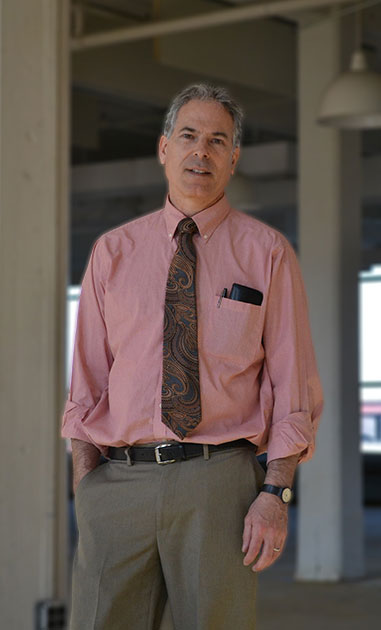12 Apr A Glance into Our Team and Their Experience
Meet Jim Speigel
Join us, as we dive into one of our Senior Project Manager’s experience with Large Scale Medical Planning:

Jim Spiegel Senior Project Manager
How long have you been with CUBE 3 Studio and what attracted you to the Company?
I joined Cube 3 Studio in September of 2015. I was attracted to the fact that Cube 3 was a young, vibrant and fast growing company with smart ownership that had a well-defined vision for near term growth and sector work diversification. I was also drawn to a firm with a clientele base primarily in the private sector. I was really impressed and thought I could fit it in well, continue to learn and add value to the firm with my years of experience and background having worked for several large firms in the past as well as run my own practice for a decade.
You have worked on a wide range of medical projects. Which medical planning project was your favorite / what was your involvement?
Each medical project had its challenges, however, I favor the Massachusetts General Hospital (MGH) In-patient Bed Tower project, now known as the Blake Building.This project created approximately 800,000 square feet of new inpatient and medical support facilities on fifteen floors. It involved the replacement of major existing buildings including the Baker Memorial, the Phillips House, the Vincent Burnham Building, and the Clinics Building. New construction was phased via a core and shell process, followed by tenant fit-up over a period of four years. The project involved an intricate sequence of staff moves, demolition and new construction. The facility features linkage from a new 60’-0” diameter roof top Heliport to new Operating Room Suites and Emergency Department at grade via dedicated high speed elevators. Programming also incorporated multiple inpatient floors and state of the art IORT imaging suites. The mechanical floor level occupied the fourteenth-floor plate just below the rooftop heliport. The helipad featured full FAA code compliance, including dual structural helipad slabs with emergency fuel spill collection and separation assembly. The project was completed in the midst of a major-medical complex, with minimal disturbance to the hospital staff and patients, with the building opening on time and on budget in 1994.
The project site was extremely tight and challenging particularly with the design of the rooftop Heliport engaging the flanking 23 story Ellison Building. The Blake Building is the shorter volume of the glass tower structures on the MGH campus.
I served as job captain for phase I core and shell and I served as a project planner for the Emergency and Imaging departments. I also had the Heliport on the roof.
What is unique about the process when developing a plan for the medical industry?
Healthcare sector hospital campus structures are one of the most intricate in the industry. What makes medical projects of this nature unique is that they most always involve complex site and facility infrastructure planning as well as project planning for multiple medical departmental disciplines. Often departments have large groups of project stakeholders, making the planning process very complex and time consuming. Departmental programming and planning can also take over a year to dovetail into the new building plan as a whole. There’s such a volume of infrastructure that goes into these sector projects, you can barely pop a ceiling. That combined with making each department function efficiently at the back of the house, while successfully enhancing the visitor experience at the front of the house is what sets hospital planning apart from most other sector work.
What were two key lessons that you learned from working on the project?
The takeaway on site and infrastructure planning is to make the best effort to plan for the longest-range life cycle possible and not to take shortcuts. Site infrastructure work is extremely costly and best to do it right the first time. Plan for 50, 75 and 100 year cycles and furnish a capital reserve study that maps out O&M expenditure requirements for 10, 20, 50, 75 and 100 year cycles and update that document every 10 years.
It is also advisable to assist the Owner with retaining the services of a Construction Manager/General Contractor (CM/GC) early in the planning process, to provide pre-construction management services. A good pre-con CM/GC will work collaboratively with the Owner and Architect and provide guidance on viability, scheduling and expense associated with broad stroke planning concepts. Having a pre-con CM/GC on board early can help to streamline the planning process and assist the Owner and Architect with establishing working values and budgets. Bringing a CM/GC on early saves on valuable project time and on project general contracting procurement time as well.
With respect to departmental program planning, it is best to have hospital executives and departmental user group leaders together when making critical decisions. My experiences have shown a negative result when executives make big move decisions in a vacuum, as those decisions may ultimately not work for those executing day to day as service providers.
Of all your experience, which project have you learned the most from and carried those lessons through your career?
I’ve learned many things on all past projects, however, on a particular large hospital expansion project there were many players on the project and a sizable design team of around twenty people. The takeaway for me was resiliency to work in a team environment and to have respect for others always, regardless of their opinions and/or egos.
What would your dream project be?
Perhaps a large scale urban mixed use development, such as a new city or campus, and located in a foreign country to make things even more challenging.
View more CUBE 3 Studio Healthcare Projects






